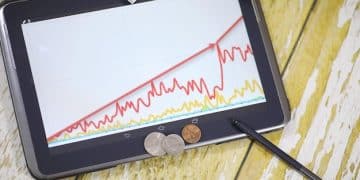Small Business Optimism Index: Latest Numbers & Economic Confidence in the US

The Small Business Optimism Index provides insights into the economic confidence of small business owners in the US, reflecting their expectations for growth, hiring, and investment, thus serving as a key indicator of overall economic health.
Understanding the **Small Business Optimism Index: What the Latest Numbers Reveal About Economic Confidence** is crucial for gauging the economic pulse of the United States, as small businesses form the backbone of the US economy.
Decoding the Small Business Optimism Index
The Small Business Optimism Index is a key economic indicator that reflects the confidence levels of small business owners in the United States. It provides valuable insights into their expectations for the future, influencing decisions about hiring, investment, and expansion.
This index is not just a number; it’s a reflection of the real-world challenges and opportunities faced by small businesses. By understanding the index, we can gain a better understanding of the overall health and direction of the US economy.
What Does the Index Measure?
The index is a composite of several key components, each reflecting a different aspect of small business sentiment. These components include:
- Plans to Increase Employment: This component reflects the percentage of small business owners who plan to create new jobs in the coming months.
- Expectations for Sales: This measures the optimism of business owners regarding future sales growth.
- Capital Spending Plans: This indicates the willingness of small businesses to invest in their operations.
- Inventory Investment Plans: This reflects expectations regarding inventory levels.
- Earnings Trends: This gauges the profitability of small businesses.

Together, these components paint a comprehensive picture of the small business environment, providing valuable signals for economists, policymakers, and investors.
Analyzing the Latest Index Numbers
Staying updated with the latest index numbers is crucial for understanding the current economic climate. Each month, the National Federation of Independent Business (NFIB) releases the Small Business Optimism Index, providing a snapshot of the sentiment among small business owners.
These numbers are not static; they fluctuate based on a variety of factors, including economic policies, market conditions, and global events. Analyzing these fluctuations can reveal important insights into the challenges and opportunities facing small businesses.
Key Takeaways from Recent Reports
Recent reports on the Small Business Optimism Index have revealed several key trends:
- Inflation Concerns: Rising inflation continues to be a major concern for small business owners, impacting their costs and pricing strategies.
- Labor Shortages: Many businesses are struggling to find qualified workers, limiting their ability to expand and meet customer demand.
- Supply Chain Disruptions: Ongoing disruptions to the supply chain are causing delays and increased costs, impacting profitability.
Despite these challenges, many small business owners remain resilient, finding innovative ways to adapt and thrive in a dynamic environment. Understanding these challenges and opportunities is essential for making informed business decisions.
The Index as a Predictor of Economic Trends
The Small Business Optimism Index can serve as a valuable predictor of broader economic trends. Because small businesses are so closely tied to the overall economy, their sentiment often foreshadows future economic developments.
When small business owners are optimistic, they are more likely to invest, hire, and expand their operations, fueling economic growth. Conversely, when they are pessimistic, they may cut back on investments and hiring, potentially leading to a slowdown.
How the Index Correlates with Other Economic Indicators
The Small Business Optimism Index often correlates with other key economic indicators, such as:
- GDP Growth: A rising index often precedes stronger GDP growth, as increased small business activity contributes to overall economic expansion.
- Unemployment Rate: An optimistic index typically coincides with a lower unemployment rate, as small businesses create new jobs.
- Consumer Spending: Small business sentiment can influence consumer behavior, as positive expectations lead to increased spending.
By tracking the Small Business Optimism Index alongside these other indicators, economists and policymakers can gain a more comprehensive understanding of the economic landscape and make more informed decisions.
Factors Influencing Small Business Optimism
Numerous factors can influence the Small Business Optimism Index, reflecting the complex challenges and opportunities faced by small business owners.
These factors can range from economic policies and market conditions to global events and technological advancements. Understanding these influences is crucial for interpreting the index and predicting future trends.
Key Influencers on the Index
Several key factors commonly influence the Small Business Optimism Index:
- Government Regulations: Changes in regulations can impact the costs and burdens faced by small businesses, affecting their optimism.
- Interest Rates: Rising interest rates can make it more expensive for small businesses to borrow money, potentially dampening investment.
- Healthcare Costs: The cost of healthcare can be a significant expense for small businesses, impacting their profitability and ability to offer competitive benefits.

By understanding these influences, we can effectively use the index to assess the small business health.
Strategies for Boosting Small Business Confidence
Boosting small business confidence is essential for fostering economic growth and creating jobs. Policymakers, business leaders, and community organizations can play a crucial role in supporting small businesses and enhancing their optimism.
By implementing targeted strategies, we can create a more favorable environment for small businesses to thrive.
Effective Measures to Enhance Optimism
Here are several effective measures to enhance small business optimism:
- Tax Relief: Providing tax relief can free up capital for small businesses to invest in growth and job creation.
- Access to Capital: Improving access to loans and other forms of financing can help small businesses expand their operations.
- Streamlined Regulations: Reducing regulatory burdens can lower costs and simplify compliance for small businesses.
- Skills Training Programs: Offering skills training programs can help small businesses find qualified workers and improve productivity.
By implementing these strategies, we can use **Small Business Optimism Index: What the Latest Numbers Reveal About Economic Confidence**, to promote job creation and economic growth.
The Future of the Small Business Optimism Index
The future of the Small Business Optimism Index will likely be shaped by ongoing changes in the economic landscape, technological advancements, and evolving business models. As small businesses continue to adapt to these changes, the index will remain a valuable tool for understanding their sentiment and predicting future trends.
By tracking the index and analyzing its components, we can gain insights into the direction of the US economy and make informed decisions about policy and investment.
Evolving Trends and Future Outlook
Here are some evolving trends and potential future developments related to the Small Business Optimism Index:
- Digital Transformation: The increasing adoption of digital technologies is likely to impact small business sentiment, as businesses embrace new tools for marketing, sales, and operations.
- Remote Work: The rise of remote work may influence hiring practices and workplace dynamics, affecting small business optimism.
- Sustainability Initiatives: Growing interest in sustainability and environmental responsibility may drive new business models and investment decisions among small businesses.
In conclusion, the Small Business Optimism Index should be seen as a critical tool for assessing the business sentiment of small businesses, understanding what the latest numbers reveal about economic confidence in the US.
| Key Point | Brief Description |
|---|---|
| 📊 Index Overview | Measures small business owner confidence in the US economy. |
| 📈 Economic Impact | Influences hiring, investment, and business expansion decisions. |
| ⚠️ Key Concerns | Inflation, labor shortages, and supply chain disruptions. |
| 🌱 Future Growth | Digital transformation, remote work, and sustainability initiatives. |
FAQ Section
▼
The Small Business Optimism Index is a metric that reflects the confidence levels of small business owners in the United States regarding the economic outlook and their business prospects.
▼
The Small Business Optimism Index is published monthly by the National Federation of Independent Business (NFIB), a leading small business association in the United States.
▼
Several factors can influence the index, including inflation rates, labor market conditions, government regulations, and overall economic growth prospects.
▼
A high index can stimulate the economy as optimistic business owners are likelier to invest, hire more employees, and take on new projects thereby fostering economic growth.
▼
The latest Small Business Optimism Index report can be found on the NFIB’s official website, usually released monthly with detailed analysis of current economic conditions.
Conclusion
In conclusion, the Small Business Optimism Index remains a vital tool for interpreting economic trends. By understanding the latest numbers, we can make better-informed decisions about the business and economic environment today.





